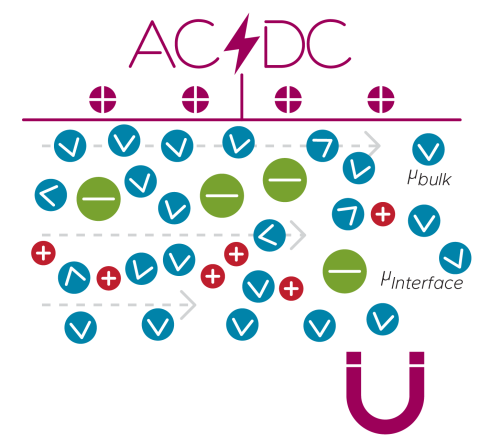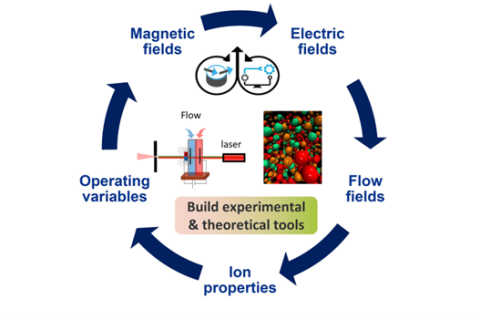Research
NETS research efforts are organized into three interconnected thrusts, all centralized around a core objective of leveraging external stimuli (e.g., electric, magnetic, and flow fields) to induce far-from-equilibrium conditions within unconventional liquid feedstocks. This innovative, specialty chemical-free approach enables precise material precipitation and fosters a zero-waste separation process. The NETS thrusts will comprehensively explore fundamental science and pragmatic methodologies that are critical for pioneering a revolutionary separation methodology. NETS places a distinct emphasis on nurturing innovative experimental and theoretical techniques—crucial not only for advancing fundamental scientific inquiries but also for strengthening the practical methodologies essential to realizing our ambitious goal in critical material separations.
Thrust Areas

Thrust 1: Field-Induced Non-Equilibrium Fluid Interfaces – Lead Maria Sushko
Selective precipitation has been widely adopted for separating ions from multicomponent solutions. Conventional batch reactors, however, are limited in their separation efficiency, particularly when dealing with feedstocks containing diverse and evolving ion compositions. Thrust 1 is focused on exploring the efficacy of external stimuli—such as electric and magnetic fields—to leverage subtle differences in intrinsic ion properties to achieve enhanced separations. The adaptability of external stimuli, in conjunction with the cumulative effect of multiple fields, presents new opportunities to precisely control ion spatial distributions and modify chemical reactivity. The primary objective of Thrust 1 is to develop a predictive understanding of the interplay between ion transport and precipitation kinetics, enabling efficient ion separations from diverse domestic feedstocks. Thrust 1 integrates novel experimental and theoretical methodologies, bridging critical knowledge gaps that are currently hindering efficient separations through far-from-equilibrium selective precipitation.

Thrust 2: Separations for Complex Feedstocks – Lead Chinmayee Subban
The primary objective of Thrust 2 is to validate an innovative field-driven separation methodology tailored for diverse non-traditional feedstocks, including mine tailings, produced waters, and industrial waste. The physical and chemical properties of these abundant domestic feedstocks vary dramatically, posing a significant challenge for large-scale separations. Thrust 2 is focused on demonstrating the feasibility and advantages of employing liquid flow and electromagnetic fields to selectively precipitate critical elements from non-traditional sources. The inherently low concentrations of ions within unconventional feedstocks pose a formidable challenge. To address this complexity, Thrust 2 involves a phased exploration of chemical diversity within the framework of industrially relevant feedstocks. This approach includes an extensive survey spanning a broad concentration spectrum of target critical elements, the formulation of industrially valuable multi-component blends, and the development of separation modules guided by computational fluid dynamics modeling and complementary experiments. The goal is to facilitate the transition of stimuli-driven separations from small-volume devices to industrially viable continuous processes. A key outcome of Thrust 2 involves a comprehensive assessment that quantifies the inherent cost, energy, and sustainability advantages of NETS methods over conventional separation approaches.

Crosscutting Thrust: Probing and Predicting Far-From-Equilibrium Across Scales – Lead Venky Prabhakaran
The Crosscutting Thrust will develop novel experimental and theoretical capabilities that provide unprecedented spatial and temporal insights into external stimuli-driven separation processes. These capabilities will be leveraged to measure and predict the properties of feedstock solutions under the influence of flow and external electric and magnetic fields. The primary goal is to develop advanced tools for the experimental visualization and theoretical prediction of how fluid flow and external fields will achieve optimal chemical potentials for the selective nucleation of targeted critical elements. This approach involves characterizing ion concentration distributions driven or modulated by fluid flow and fields alongside simulations demonstrating how field-driven processes are influenced by these external stimuli. The overarching aim of the Crosscutting Thrust is to model how localized fluctuations translate into observable variations in broader transport properties. These efforts will culminate in establishing fundamental design principles for fluid flow and fields as well as defining spectroscopic signatures for critical materials. The Crosscutting Thrust will guide the selection of process parameters and benchmark approaches for real-time monitoring, thereby facilitating adaptive and automated process control.